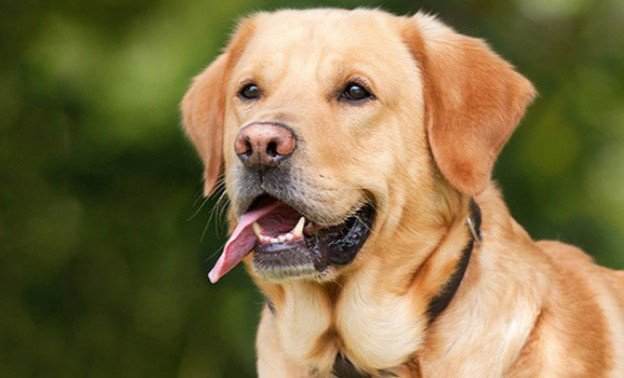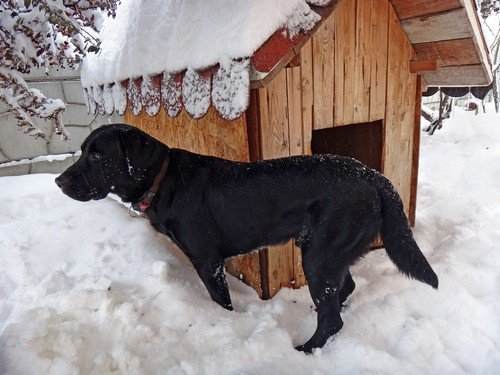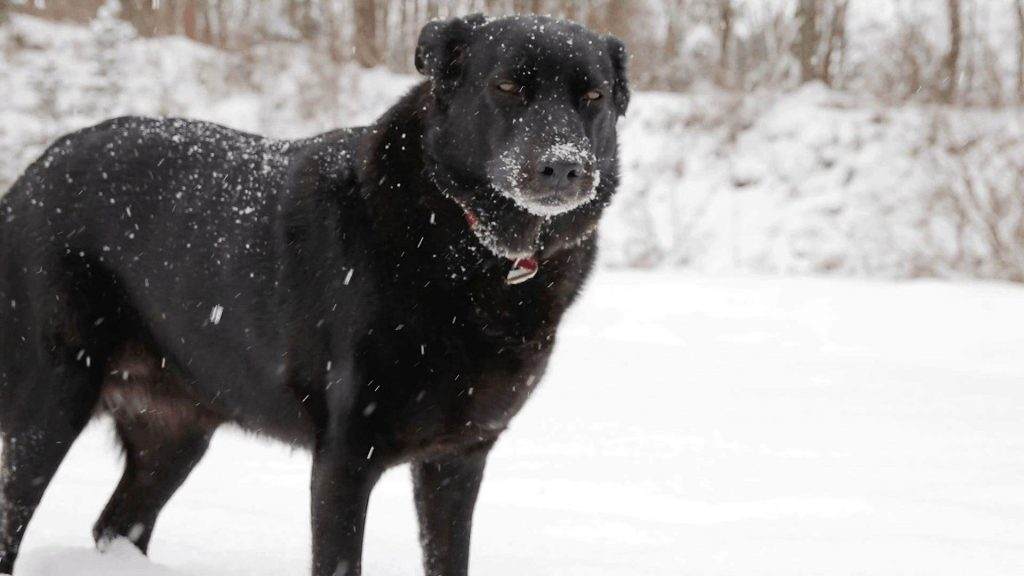When you own a Labrador dog, it is very natural to have this question come to your mind in winter season. Do Labradors get cold at night? Temperature is a big concern when the Labrador spends whole night outside in the open. So the answer is yes they do feel cold and can get sick when exposed to low temperatures.
Getting an insulated cover for your Lab can help him stay warm during the night. There are many other tips which we shall cover in this article, but an insulated kennel cover goes a long way in providing the comfort that your Lab dog needs during night time. Check this kennel cover on Amazon which I shortlisted for our readers.
As the season starts to change, getting ready for the winter season is a good idea. This applies also for the change in season from winter to summer so you start to prepare for summer the same way when the season is changing.
Historically, How Labradors Have Fared in Winter
Labs originated in Newfoundland, Canada in the 1800s. They were bred from the famous St.John’s water dogs and trained to brace the chilly water of Newfoundland. Here, the water temperatures vary from 32 F (00C) during winter and 56 F (130C) in summer.
At the time Labrador was known as the St. John’s or the lesser Newfoundland dog. Later on, British fishers settled in Newfoundland making St. John’s dogs apart of their fishing excursions.
It was then that it adopted the retriever name as it would dive into cold water to catch stray fish and help pull in fishing nets. They have since developed a tolerance for cold which begs the question; do Labradors get cold at night?
The Use of Labrador’s Coat
A lab’s coat protects it from the rigors of the harsh winter weather. The undercoat has short, cotton-like hairs prevent heat loss through insulation while the topcoat provides weather-repellent qualities.
In Fact, Labradors Have Double Coat

Labs have a double coat: the topcoat called the Guard coat and the second is the undercoat. The Guard coat is rougher and more abrasive while the undercoat feels light, soft, and fluffier. The layers help regulate body temperature, repel water, and protect the skin from UV rays.
The undercoat is also an excellent insulator keeping your lab warm during chilly weather and cool in the summer season. It is this feature that helps Labrador dry off fast after swimming. The undercoat secretes natural oil which repels water and keeps the skin dry.
These oils also keep the coat smooth and shiny. It explains why it is not advisable to bath your lab regularly. It only strips off the natural oils that protect the coat leaving it dry, flaky and itchy.
Experts advise bathing your lab once a month using coconut-based dog shampoo or mild oatmeal to keep the skin moisturized. You should also brush the hair once or twice a week to remove any dirt trapped in the hairs. If left unattended, the dirt accumulates leading to a foul smell and extreme cases skin infection.
Parameters to Consider Apart from Temperature
Several factors come into play when it comes to managing labs during the cold season. Some labs get cold at night while others can brace the season comfortably. You want to consider these factors when looking for a suitable way of managing your lab at night:
- Age: Old and young labs don’t regulate their body temperature as well as those in their prime years. They need extra work to keep warm during the night
- Weight: Fat provides adequate insulation against cold. Thus, skinny labs are likely to feel colder than heavier ones. Bring them in earlier and increase their calorie-intake.
- Dampness: If your dog has been swimming or just had a bath, then it needs extra attention to keep it warm at night. You may increase the amount of food it takes or covers it with a warm blanket
- Cloud cover: Cloudless nights are colder than cloudy ones

How to Determine Specific Case of Your Lab Getting Cold in Winter Nights
Dogs have a higher body temperature than humans; thus, if your canine feels cold when you touch him, it is feeling a little bit cold than normal.
Usually, the blood circulation will concentrate on essential body parts, including the trunk area with little flow to other parts like the ears, legs, nose, and paws.
The lab also tends to shiver a lot when it gets freezing. It may hunch its back or keep its tail tucked close to its body to stay warm. Prolonged exposure to such cold can lead to the development of conditions like frostbite in the tail, ears, and feet.
How to Make Labrador Comfortable in Cold Nights
While Labradors are suited for the outdoors, it is crucial to ensure they are comfortable during extremely cold nights. They are prone to conditions like frostbite and hypothermia during extreme temperature drops. Here are a few things you can do:
1. Insulate the Doghouse
A regular dog house deflects wind and rain but barely provides warmth. Consider insulating the structure to block out the cold and keep your lab warm. It should be large enough for him to stand, sit, stretch, and lie down.

Also, outfit a heavy wind flap at the entrance and lay non-porous bedding. Straw or hay make excellent materials as towels, or fluffy blankets can get wet, leaving your lab cold. Alternatively, look for an insulated floor mat.
Labs lose a significant amount of heat when in contact with a cold surface. The mat prevents loss of heat and insulates the kennel floor. The house should be in a sheltered place, away from the wind and off the frozen ground.
2. Wrap the Doghouse in Insulated Covers
The cover comes in handy if your lab stays outside most of the time. Look for a warm cover fitted with holders and pockets, especially if you are the kind that goes for daily excursions.
3. Hydrate
Despite the chilly weather, labs get dehydrated. Their bodies need to expel more energy to keep warm hence the need to provide adequate water. Setting out enough water in the morning is not enough because the water may get frozen as the temperature drops.
Your lab is likely to keep off from taking the frozen water leaving it dehydrated. Be sure to refill the bowl with fresh water to keep it well-hydrated.
4. Brush the Coat Regularly
Matted coats don’t insulate adequately. Snowballs get stuck on the double coat which causes matting if it is not brushed out.
How to Choose the Right Dog Kennel for Winter
Labradors have muscular builds and can grow to heights of up to 22 inches. As such, it is essential to look for large kennels that allow them to sit, stand, and lie down while staying warm. Here are some things to consider when buying a kennel during winter:
Size
A good kennel should provide enough space for the lab to turn around and leave a few extra inches at headspace when it is sitting or standing. If you have a young lab, purchase an adult-size kennel, and partition off the extra space.
The weight of the lab should help you estimate the ideal size of the kennel. For example, a 24-inch kennel is perfect for a lab weighing 25 pounds while a 48-inch crate is excellent for labs weighing 91-110 pounds.
Building Materials
Traditionally, lab kennels are made of metal, wood, or a combination of both. Wooden kennels have excellent insulating features but can be challenging to clean and carry during travel. You want to keep off from buying a metal kennel as it is ideal for a humid climate.
New forms are available in plastic and provide robust, durable, and well-ventilated options. However, they don’t have the same insulating features like wood and may not keep your lab warm during winter. Plastic kennels are useful when going on short trips.
Sturdiness
The structure should be escape-proof. Labs are large and boisterous hence the need to look for a strong and heavy kennel that is difficult to tip over when playing. They should be outfitted with ground anchors to keep the structure planted firmly on the floor.
Look out for other features like broad tube framing, the size of the chain link, and the gauge wires to determine the strength and durability of the kennel. Additionally, the frame should be galvanized after the welding process to wade off the rust.
Door Construction
Choose a structure that allows you to add a door to help contain the heat in the kennel. A swing door is more suitable because the lab can easily open from the outside and inside.
Warm Food and Fresh Water to Drink Helps a Lot
Labs live in the outdoors almost exclusively even during the cold winter months. Their dietary requirements increase, as a result, to provide enough energy to survive the cold. Dogs just like humans have a constant body temperature which, when altered (in this case by the low temperature) causes the body to shiver.
Shivering consumes a lot of energy hence the need to increase the amount of food the lab eats by two or three times. The calorie intake may be much more if the dog is active.
The Utah Humane Society requires working labs to consume as much as 15% additional calories for every 20-degree reduction in temperature.
This is because an outdoor dog’s body uses fat instead of glucose for energy. Adding a small amount of vegetable oil or animal fat to the dog’s diet helps meet these metabolism requirements.
Water is another essential requirement for proper metabolism. Ensure it takes sufficient fresh water to avoid dehydration. Avoid giving it freezing water as it slows the digestion rate and keeps the lab from getting adequate energy from his food.
A good rule of thumb is to monitor the amount of water the lab takes every day. Refill the water bowl at the same time daily and with the same quantity to determine the exact amount your lab needs.
Is There a Limit to Low Temperature That Lab Can Withstand?
Most vets recommend bringing your lab indoors when temperatures hit below 20 F (-6.7 C). Labs get pretty cold when temperatures dip that low and risk developing cold-related problems like frostbite and hypothermia.
The dog’s body language should help you determine if it’s time to bring it inside. Some dogs start shivering while others become inactive or anxious.
What’s more, extreme cold can aggravate some health conditions like joint disorders and arthritis. Read on to find out conditions Labrador dogs develop during winter.

Medical Issues in Winter for Labrador Dogs
Frostbite
The condition develops when the dog’s body gets extremely cold. Body circulation occurs at the center of the body, leaving the dog’s paws, ears and tail so cold that ice crystals are likely to form in the tissue and damage it.
It’s not easy to identify the condition, but lab owners should watch out for grey or pale skin. Also, the dog may develop alternative lifting of the feet due to pain or blisters. Severely frostbitten skin eventually turns black and falls off
Cracking of the paws
Salts and chemicals used to de-ice roads and sidewalks irritate a lab’s pads leading to cracking. The salt dries off on the dog’s pads, causing them to crack.
To prevent the condition, lab owners should soak the dog’s paws in warm water after a walk or run and dry them thoroughly
Hypothermia
It occurs when a lab is exposed to extreme cold for extended periods. In mild cases, the dog shivers and the ears and feet become cold. As the condition worsens, the muscles become stiff, the breathing and heart rate slows down, and the dog does not respond to stimuli.
References
- https://journals.lib.unb.ca/index.php/NFLDS/article/download/21031/24257
- https://books.google.com/books?hl=en&lr=&id=Y-1MBAAAQBAJ&oi=fnd&pg=PT5&dq=Dog+care&ots=1NTPCjMgtf&sig=jTzi8wtZiw4hNw_hPyWBjVciOjM
Table of Contents
